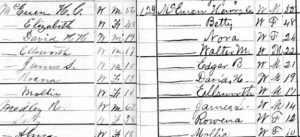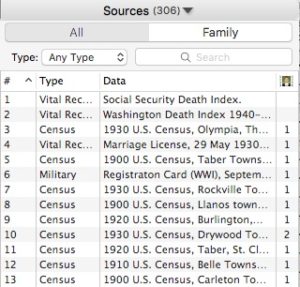 I used to print all my source documentation and then analyze the printed version and add facts to my Reunion software on my computer. In fact, as recently as 2013 I blogged about how printing gave me comfort.
I used to print all my source documentation and then analyze the printed version and add facts to my Reunion software on my computer. In fact, as recently as 2013 I blogged about how printing gave me comfort.
But that’s changed and these days I’m not even tempted to print. In November, I posted 8 reasons not to print and I stand by it. Organizing my research is much easier now that I’m not looking at a lot of printed documents. Every now and then I pull out a paper file and look at something I printed years ago, but I bet that happens fewer than ten times a year.
Right now I’m going through all my source documentation and in the process cleaning up my electronic files. In doing so, I found the family who had been counted twice on the 1880 census. I needed to compare the two census documents side by side. That’s when I felt the urge to print. My initial thought was that it would be easier to look at the documents on paper, rather than on my computer. One of the documents had already been printed and was in my file. I came really close to printing out the other one, when I realized that looking at the paper documents would be harder for me, not easier. The type is so small on the printed document that I might have had to get out my magnifying glass and squint. That’s the opposite of easy!
I had originally found the census documents on Ancestry and saved them to my hard drive. So I just opened the documents on my computer in Preview (that’s the Mac default pdf and jpg viewer), zoomed in on the family in question and sized each of them so that they fit side by side on my screen easily–I didn’t need to see the entire document at a glance, after all. And then I was able to easily compare them, line by line. I had Reunion open as well, so it was simple for me to enter data into my ancestors’ records and source each fact properly.
What I’m learning in my research, over time, is that going paperless is just plain easier. When I transcribe my ancestors’ Civil War pension files, I use an electronic version, which allows me to zoom in when the handwriting is a little puzzling. And I’m not shuffling a lot of long pieces of paper. (Those documents came from the National Archives in paper form. I put source information on each and then scanned the whole file into one long pdf. I detail that process here.)
The keys to successfully eschewing printing, I believe, are twofold:
- A good file naming protocol and folder structure, so that I can easily see what I have for each ancestor. I file by surname and individual, which is working well for me.
- A solid backup protocol, in case of hard drive failure. I use CrashPlan Pro to back up to the cloud and Time Machine to back my Mac onto an external hard drive that sits on my desk.
As commenter Maria Tello mentions, having a large monitor makes viewing electronic documents easier.
I was glad I resisted the urge to print that 1880 census document. It made analysis easier–and I’m sure it was easier on my eyes!
 This year I’ve been having the hardest time figuring out what I want to focus on in my genealogy research sessions. I think part of the problem is that I’ve also had trouble finding time to research, so it’s been more sporadic. And when I do have time, then I don’t know what to work on.
This year I’ve been having the hardest time figuring out what I want to focus on in my genealogy research sessions. I think part of the problem is that I’ve also had trouble finding time to research, so it’s been more sporadic. And when I do have time, then I don’t know what to work on. If you’re going to RootsTech next week (or any other genealogy conference this year) I encourage you to check out the free template I created in
If you’re going to RootsTech next week (or any other genealogy conference this year) I encourage you to check out the free template I created in  When I started this blog in 2012, I printed everything. I did a lot of research online, but I would print out the documents I found online and read the printed version. Then I would file them in my
When I started this blog in 2012, I printed everything. I did a lot of research online, but I would print out the documents I found online and read the printed version. Then I would file them in my 